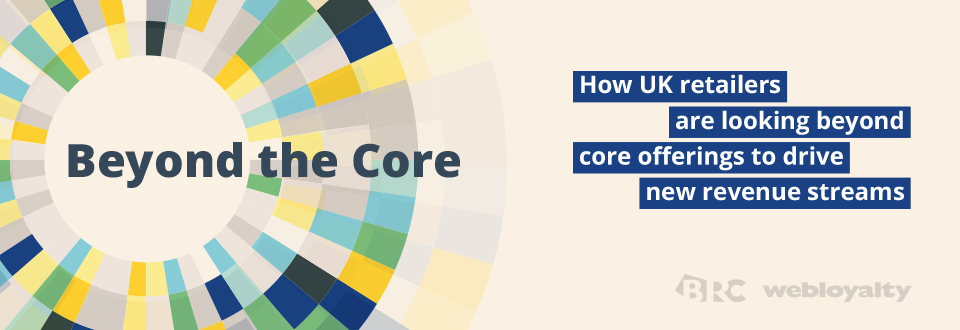We already know that technology plays a double-edged role in consumer loyalty. With the expansion of global eCommerce retail, merchants are enjoying a larger market than ever before, consumers themselves are also aware of the options that internet retail has brought forward.
As of 2015, the average UK consumer “traveled” – or at least their purchased items did – 6,281.2 miles; almost the distance of a return trip between London and New York. Stats like this illustrate the vast possibilities available to consumers and the challenges that both brick-and-mortar retailers and their ecommerce counterparts are up against.
Fragmentation of markets and the capricious will of the consumer mean that a once reliable customer base can no longer be the guaranteed source of revenue it was. Secondary streams must be found.
As Webloyalty’s recent report Beyond the Core: How UK Retailers are Looking Beyond Core Offerings to Drive Revenue Streams states, loyalty and reward schemes are the most commonly used method of secondary revenue.
So why do consumers continue to shop elsewhere and how can these schemes be implemented in such adverse conditions?
The Size of the Problem
“The vision for loyalty is always exciting,” explains Edwina Dunn, CEO of pioneering data-driven business strategy consultant, Starcount. “But the reality is that only a small group of people will be loyal. That’s a special group. They are vitally important and if you don’t know who they are then you could be missing out on extra revenues. Loyalty programmes drive secondary revenue by retailers knowing more about their customers through data and being able to sell them more goods and services on the back of this.”
By offering a loyalty programme, retailers can convince customers to spend more, more frequently.
“This group is very lucrative but it is never big enough. It could be only 1-2% of your total customers. It does make you wonder why it is not bigger,” says Dunn.
Oiling the Wheels
The hyper-competitiveness of the internet age has drastically weakened the foundations of customer loyalty, as Webloyalty’s report, The Unfaithful Consumer, illustrates. Customers have a wider selection of options than ever before and so consumer behaviour is far harder to predict.
Dunn poses a question: “If a company is trusted with one part of the shop then why not another?”
While a retailer’s databank can offer some insight into the behaviour of their own consumers, Dunn believes it simply isn’t enough. Data must be live, constant, and at the very centre of each retailer’s strategy: “Using data is should be like putting oil in a car. If you don’t know if it is going to every part of the engine then you can’t drive the car,” she says.
Changes up Top
Implementing a loyalty and reward programme is only worthwhile if the data a retailer has is large enough to provide an in-depth picture of their consumers’ behaviour. Frequently, the legacy model stores, such as John Lewis or Marks & Spencer, do not.
The type of customer they attract tend to do their shopping in-store where data harvesting is limited. Additionally, their business organization creates a system far less flexible than younger, frequently online, retailers. The same can be said about the individuals filling their leadership positions. “These companies need to bring in people who understand the mix of old and new skills and to place them in leadership roles”, says Dunn.
Farfetch, Asos, and Boohoo are three retailers that Dunn believes fully understands and applies the power of data to leverage loyalty from their consumer base. “The people working at these new retailers are a generation who have always known how to use mobile devices and they’ve learned to live and breathe data”, she says.
The Future of Loyalty
As Webloyalty’s The 5Ps of Shopper Motivation report showed, consumers who will shape retail in the future overwhelming favour online shopping. For retailers, there is an incredible need to get their online strategy right now so that their secondary streams can be supported in years to come. So what are the best options?
“Retailers should be taking 50% of their TV budget to spend on Facebook and Instagram,” says Dunn. “Data should be on the boardroom agenda – it drives secondary revenue and it will make a company ten times more efficient. But it is critical to have a person who has power and respect on the board supporting it. It’s not about simply bringing in a geek every quarter to put the case forward.”
Beyond the Core
Webloyalty has partnered with the BRC to publish our first Beyond the Core research report, a study into how UK retailers are looking beyond core offerings to drive new revenue streams. The report provides valuable insight into the application of secondary revenue generation amongst UK retailers.
